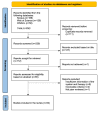Playfulness and New Technologies in Hand Therapy for Children With Cerebral Palsy: Scoping Review
- PMID: 37843886
- PMCID: PMC10616756
- DOI: 10.2196/44904
Playfulness and New Technologies in Hand Therapy for Children With Cerebral Palsy: Scoping Review
Abstract
Background: Innovative technologies such as game consoles and smart toys used with games or playful approaches have proven to be successful and attractive in providing effective and motivating hand therapy for children with cerebral palsy (CP). Thus, there is an increased interest in designing and implementing interventions that can improve the well-being of these children. However, to understand how and why these interventions are motivating children, we need a better understanding of the playful elements of technology-supported hand therapy.
Objective: This scoping review aims to identify the playful elements and the innovative technologies currently used in hand therapy for children with CP.
Methods: We included studies that design or evaluate interventions for children with CP that use innovative technologies with game or play strategies. Data were extracted and analyzed based on the type of technology, description of the system, and playful elements according to the Lenses of Play, a play design toolkit. A total of 31 studies were included in the analysis.
Results: Overall, 54 papers were included in the analysis. The results showed high use of consumer technologies in hand therapy for children with CP. Although several studies have used a combination of consumer technologies with therapeutic-specific technologies, only a few studies focused on the exclusive use of therapeutic-specific technologies. To analyze the playfulness of these interventions that make use of innovative technologies, we focused our review on 3 lenses of play: Open-ended Play, where it was found that the characteristics of ludus, such as a structured form of play and defined goals and rules, were the most common, whereas strategies that relate to paidia were less common. The most commonly used Forms of Play were physical or active form and games with rules. Finally, the most popular Playful experiences were control, challenge, and competition.
Conclusions: The inventory and analysis of innovative technology and playful elements provided in this study can be a starting point for new developments of fun and engaging tools to assist hand therapy for children with CP.
Keywords: cerebral palsy; children; hand therapy; play; technology.
©Tamara Veronica Pinos Cisneros, Annette Brons, Ben Kröse, Ben Schouten, Geke Ludden. Originally published in JMIR Serious Games (https://games.jmir.org), 16.10.2023.
Conflict of interest statement
Conflicts of Interest: None declared.
Figures
References
-
- Novak I, McIntyre S, Morgan C, Campbell L, Dark L, Morton N, Stumbles E, Wilson SA, Goldsmith S. A systematic review of interventions for children with cerebral palsy: state of the evidence. Dev Med Child Neurol. 2013 Oct;55(10):885–910. doi: 10.1111/dmcn.12246. https://onlinelibrary.wiley.com/doi/10.1111/dmcn.12246 - DOI - DOI - PubMed
-
- Velasco MA, Valle B, Raya R, Clemotte A, Ceres R, Bueno MG, Rocon E. BiMU—inertial sensors and virtual reality games for the rehabilitation of the upper limb in cerebral palsy. Proceedings of the 3rd International Conference on NeuroRehabilitation; ICNR '16; October 18-21, 2016; Segovia, Spain. 2017. pp. 1067–71. https://link.springer.com/chapter/10.1007/978-3-319-46669-9_173 - DOI - DOI
-
- Rodger S, Ziviani J. Play-based occupational therapy. Intl J Disabil Dev Educ. 1999 Sep;46(3):337–65. doi: 10.1080/103491299100542. https://www.tandfonline.com/doi/abs/10.1080/103491299100542 - DOI - DOI
-
- Aarts PB, van Hartingsveldt M, Anderson PG, van den Tillaar I, van der Burg J, Geurts AC. The Pirate group intervention protocol: description and a case report of a modified constraint-induced movement therapy combined with bimanual training for young children with unilateral spastic cerebral palsy. Occup Ther Int. 2012 Jun 12;19(2):76–87. doi: 10.1002/oti.321. doi: 10.1002/oti.321. - DOI - DOI - PubMed
Publication types
LinkOut - more resources
Full Text Sources
Miscellaneous




